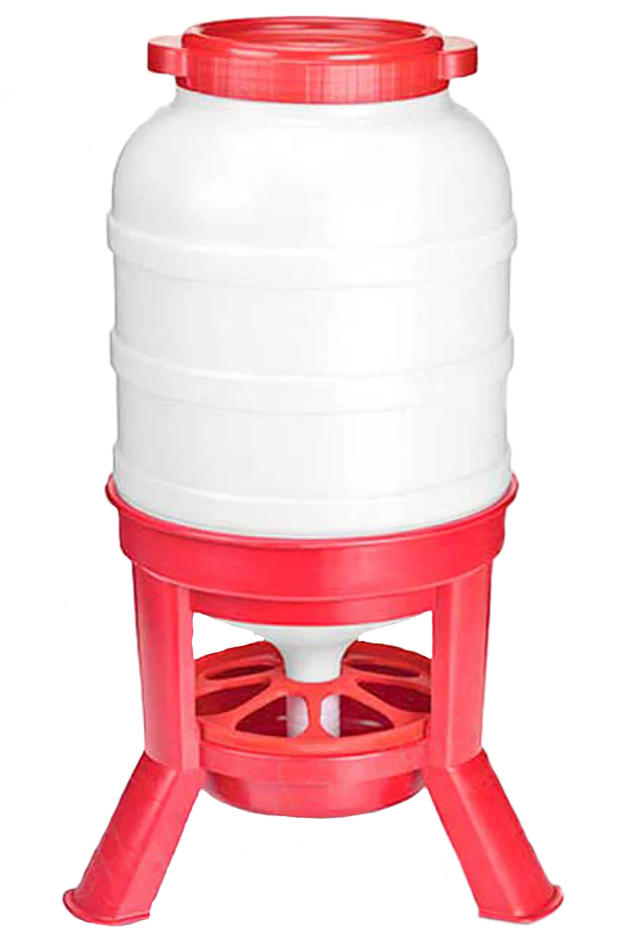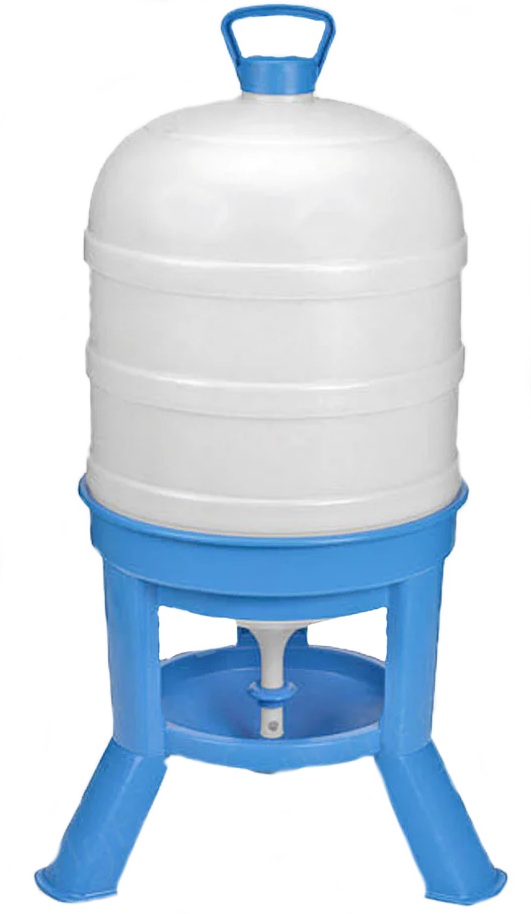If you want eggs, you need happy, health hens and in turn, they need good food and fresh water and somewhere dry, clean and safe to live.
Ours hens regularly get all sorts of kitchen scraps from vegetables peelings. Stick them in a pan, heat them up for a couple of minutes, let them cool and you have a tasty food source that they really love from items you would, without Chickens, put in the compost bin, so its effectively free food that turns into eggs. The hens always come running to the pen door when they see you coming with the plastic pots full of food.
Chickens need a constant source of food and water and luckily, we have a farm supplies shop nearby that sells 25Kg bags of chicken food, either in pellet form or powder form, however, the girls can be really picky about what they want to eat this week, so we mix and match the foods for a bit of variety. There is always a 40kg feeder full of food and a 40 litre water feeder, full of water and any additives we may need, such as apple cider vinegar, to control parasites and a seaweed vitamin supplement to help them stay healthy. The feeders are from Gaun and look like this :
Food is the red one and water is the blue one. They stand at 85cm high


When the weather is wet and the wind is in the right direction, water blows into the bottom of the feeder and it becomes blocked when the food gets damp and then solidifies to a substance that is fairly hard to remove. This in turn means that the hens are not getting enough food and they will tell you this by loud squawking. Similarly, the water feeder is a large vessel that feeds water due to vacuum. When the bottom drinking area gets low, air goes in at the bottom and the main sealed container, then lets some water to come out, until the hole is blocked again. The water hole can get blocked by bacterial growth, or if its very cold, it freezes. Similarly, if the top is not screwed on tight enough, the all the water leaks out as there is no vacuum.
How can I monitor the consumables ?
A solution must therefore be possible to monitor the level of the supplies and ensure that there is plenty present and that its being consumed at a fairly linear rate as that indicates it is not blocked and its working properly. Obviously the rate of consumption changes through the year. Chickens eat more when its cold and drink more when its hot.
One of the problems is that these feeders are at opposite ends of the pen and there can be no wires running to them, so any solution must be completely stand-alone and self powered. They also have lids that must be removed regularly, hence any solution cannot impact that.
After a little contemplation, a design started to materialise. If there was a PCB in the top of each feeder that could sense the important things such as the level and temperature then send the readings back to the main system, that's all that is needed. that is all that is really necessary.
But, how will I sense the level of the consumables? Various sensing options were considered including:
- A pressure sensor at the bottom that can measure the weight on it, however this would be impacted by the height of the pen above sea level and atmospheric pressure, so that wasn't a good option, notwithstanding that the sensors are prohibitively expensive.
- How about weight ? Hold the feeders up on a frame and measure the weight being pulled down
- Use Ultrasonic distance measurement facing down into the feeder
- A capacitive sensor in the water to measure the height, but that won't work on the food, so its not ideal
There is also the problem of how to mount to the water and food feeders. both have screw on lids, that need to be regularly removed so that new consumables can be added or the internals can be cleaned, so it cannot be blocked in any way.
Attachment by replacing the lid is the only viable method to use and it means that the existing lids remain unmodified, so they can be re-used if necessary in the future. After a number of hours in Confusion 360, which is free for personal use, I was able to try various design options from narrow vertical ones to flatter wider ones, a viable design becomes apparent.
The only viable sensor type is ultrasonic, but waterproof ultrasonic sensors are expensive. What if I mount the sensor facing downwards, with an O-ring on the metal body. This can prevent much of the moisture from getting into a housing above it. The sensors are very cheap, so even if one fails every so often, its still cheaper than a proper waterproof ultrasonic module, since they are hundreds of pounds a go. There is a problem though that the sensors are not airtight, so that won't work to keep the vacuum that the water feeder uses to regulate flow. The whole top unit must therefore be an air-tight assembly instead, with any couplings being air tight via the use of an O-rings to seal things.
It would also be nice if the same design could be used on both the food and water feeder as that would be cheaper and simpler to design and build. I also need a power source, a small solar panel into the top of each will provide some power to the unit, but the power budget is very low, assuming that its operating all year round and the winter has very little power.
After a bit more thinking and considering the options, a viable solution appears.
There must be a top on whatever goes into the design, to keep water out. The food feeder lid is large at about a 25cm diameter, but for the water feeder it is much smaller at a 7cm diameter. If I expand a housing to about 15cm or so, then I have a nice top where I can house a solar panel. Under that is plenty of space for a 100mm x 100mm PCB and you can get those made very cheaply at PCBWay.
What I end up with is 4 different components, a top and bottom part for the food feeder and a top and bottom for the water feeder. The water feeders top uses the existing thread and the bottom screws into that top, protecting the whole system inside the food feeder, where its dry. For the water feeder the bottom assembly screws onto the smaller threaded top, it expands out to give the required PCB space and an upper thread allows a top to be screwed on. The neat part is that both bottom parts are 90% the same, with only the bottom threaded part removed for the food feeder, since its not required. The spacing in the bottom of each assembly allows for the ultrasonic module to be placed under the main PCB. O-ring grooves in both assemblies allow for sealing of their two parts and an additional seal to the feeder.
A small hole is required in the top to get the connections to the solar panel, this obviously impacts the airtight nature of the assembly, but if the solar panel is bedded in on silicon sealant, then that provides a mounting and water and airtight seal. I just have to hope that the silicon doesn't attack the solar panel when its curing.
